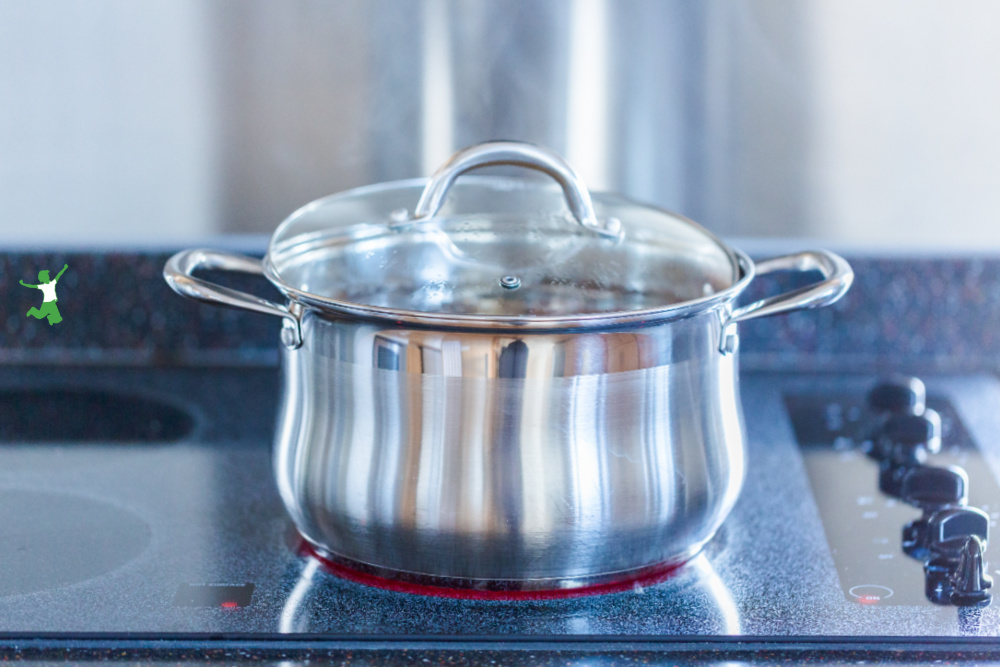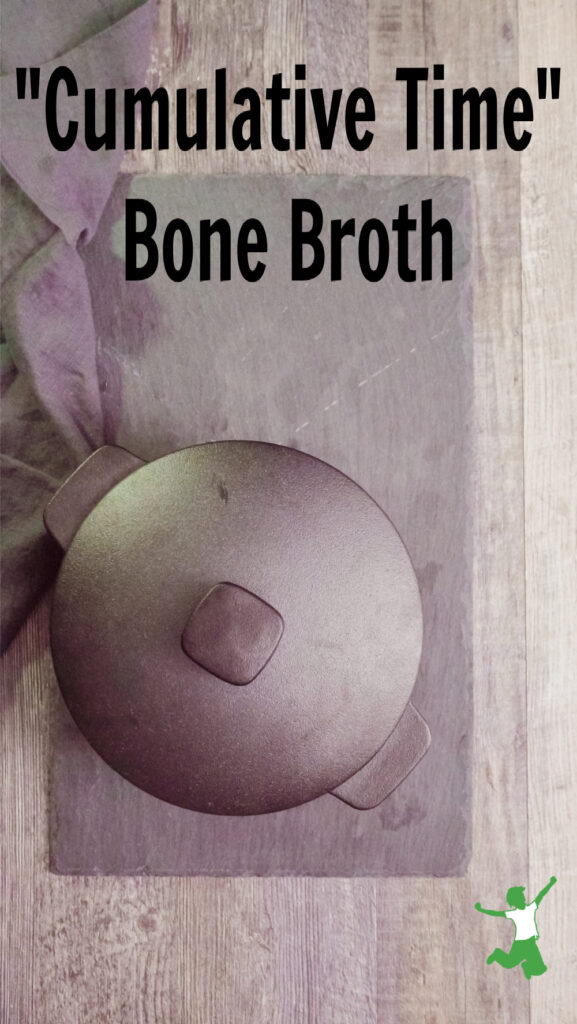Table of Contents[Hide][Show]
How to follow the “cumulative time” method for making bone broth, a strategy that does not involve leaving a simmering pot on the stove overnight or unattended while you are out of the house.

A big concern people have when they start learning how to make bone broth at home is about leaving a simmering stockpot on the stove for many hours.
Depending on when you start the process, this could entail leaving the pot simmering overnight or while you are out of the house temporarily.
This can be an unacceptable fire risk, so what to do in those situations?
While successfully producing a gelatinous pot of broth is critical, it should not involve a safety hazard to accomplish!
Fortunately, there are several options for avoiding this problem.
First of all, you can make meat stock or fish head broth. Both of these require only a couple of hours at the most to make.
If you are so time-crunched that you need something even quicker than that, I suggest bonito broth. This type of stock only requires the time necessary to boil a pot of filtered water.
Cumulative Time Bone Broth
At some point, however, you are going to need to make a proper pot of chicken or beef stock.
This type of long-simmering broth will require significantly longer than a couple of hours on the stove or in a slow cooker like a Vita-Clay.
In that situation, the cumulative time method is recommended. This is the approach suggested by Monica Corrado, CNC CGP of Simply Being Well.
She introduced me to this concept at a traditional health conference in Baltimore.
Monica really knows ancestral cooking like few others I’ve ever met. In addition to being a chef, she’s also a GAPS Practitioner. She has significantly helped my husband with his GAPS Diet journey…which requires a lot of properly made bone broth.
According to Monica, the cumulative time approach for making bone broth simply means that the required simmering time for a particular type of stock can either be continuous or broken up into sections that equal the total required duration when added together.
The catch is that each time you start to heat the broth again, you must bring it to a boil, skim the foam, and then lower the heat back down to a simmer.
Avoid the temptation of simply bringing the pot back to a quick simmer.
You must bring it to a boil first, skim and then reduce the heat to a simmer with the lid on. In other words, just repeat what you did at the beginning of the process.
What to Do When the Heat is Turned Off
There is no need to move the stockpot in and out of the refrigerator between simmering sessions on the stove.
This is because the pot stays very hot for hours after the heat is turned off.
For pathogens to start to grow, the stockpot would need to be at room temperature for 4+ hours.
Anyone who is experienced in making stock knows that a stockpot with the lid on will stay hot for many hours. It won’t get to room temperature for 4+ hours for at least half a day!
In my experience, the pot also will not get to room temperature if you turn off the heat and leave it on the stove overnight.
If the length of time to make bone broth had you concerned in the past, try the cumulative time approach!
An easy way to keep track is to keep a little notebook in the kitchen. Then, you can log the total amount of time the stock has simmered. This will ensure quality, gelatin-rich broth when you are finished.
Making stock safely couldn’t be easier when using the cumulative time method!









Can stock be made in the oven? I make spaghetti sauce, ‘boiled’ dinner and other things that you would do on stovetop. I can use oven timer to shut off automatically. Often cook overnight.
Would a crockpot work?
Simmer it in the oven. No worries!
You can also save a lot of power or gas by using a method called “heat retention cooking” or hay box cooking.
Basically you bring your pot to a boil then you wrap it in some aluminium foil and a thick layer of blankets or towels (perhaps put that into a cooler as well).
You have no fire risk using this method and your pot will continue to simmer for several hours (4 hours or longer) without any kind of attention.
I use a crockpot. My husband won’t allow continious on the stove, and I dont have time for the cumulative approach. In NZ we don’t cook the bones that long, it did not gel, but I even double cook bones with great results in the crockpot
I’d like to learn more about glutamate formation in stock when using a pressure cooker. Can you share some citations from the scientific literature? I’m finding it difficult to put together search terms precise enough to find articles.
It’s important not to try to make too much stock. I expect a quart and a half from the carcass of one roasted chicken, and often cook it down even more to save storage space. My stock always gels with a wide variety of timings. For more flavor, simmer shorter; more minerals, until it’s opaque, tea-with-milk color from all of the dissolved bone. It’s usually almost as hard as commercial Jell-o preparations.
My favorite method takes advantage of freezing temperatures outside. Simmer 1-2 hours, add vinegar, leave on the back porch overnight; then simmer 1-2 hours the next day, cool and package. The freezing with acid seems to break it down as though it had simmered for many more hours, and it preserves more of the flavor.
I’ve been doing this for a few days now and I really like it. When my crockpot is on low, it brings the broth to a gentle boil. At night I just leave it on the warm setting. When I want broth, I lower a wire strainer into the crock pot and dip my broth out of the strainer into cups to cool and replace what I took out with fresh water. I bought a dedicated crockpot for this on the path to doing the GAPS diet.
http://nourishedkitchen.com/perpetual-soup-the-easiest-bone-broth-youll-make/
I bring stock to a boil on the top of the stove, then transfer it to the oven. I put the temp at 235 degrees F. (Your oven might vary) That keeps the covered stock pot at a perfect simmer. I simmer the pot in the oven starting in the evening and leave it simmering all night. My oven has digital controls, so I set the timer to turn the oven off about 3:30 AM. It then has time to cool before I leave for work. IMHO, the oven is much more efficient, energywise. The gas cooktop is a very inefficient heating device. My crockpot has two settings: too high, and too low, so I don’t use it much unless I am close by to watch it.
Why vinegar ? I have been making stock for years and never heard of adding it what does it do exactly and can I use Bragg’s brand ?
Vinegar is said to help leach the minerals out the bones and into the broth. Bragg’s is supposed to be a very good brand, especially the organic one.
I use my 6-qt crockpot for stock, but I also bought an electric roaster oven for making bigger batches. I can roast beef bones in it for an hour or so, then add my water, vinegar and other stuff. I can set the temp so it just barely simmers and, like the crock pot, I don’t mind leaving it on overnight (I prefer not to leave a pot to cook all night on my gas stove). If I can’t make stock right away, I save chicken carcasses in the freezer and then dump them all in the roaster oven for a big batch of broth.